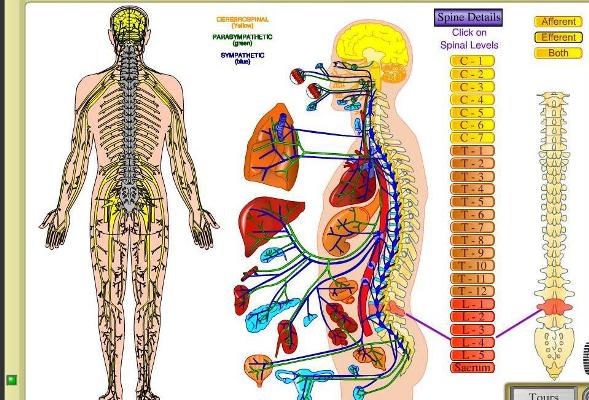Spinal Cord, Brain and Nerves Overview
Understanding central nervous system of human body is interesting. Spinal cord and brain together is called as central nervous system. The framework consists of 100 billion neurons and nerves forming a complex machine to control our actions and body. It is part of every function we do and choose to perform. Walking, sitting, standing all the responses to actions are result of nerves, spine and brain.
Brain structure
Brain weighs about 1.14kg. It contains two types of tissues - grey matter and white matter. Grey matter - process nerve impulses and white matter helps in transmission of impulses. Cerebrum is the largest structure in brain, divided into two portions or say hemispheres. Other parts of brain involve the cerebellum, the brain stem, and a central region that includes the thalamus and hypothalamus. Spinal cord extends from the brain stem and continues from the skull base.
The external layer of the cerebrum, the cerebral cortex, is made of grey matter. Underneath are white matter and islands of dark matter.
Role of the spinal nerves & Spinal cord Structure

Spinal cord structure
Spinal cord consists of nerve cell bodies with core grey matter, dendrites and other supporting cells. White matter surrounds the grey matter containing nerve fibers carrying signals from both the sides of the brain and body parts through the spinal cord length.
Many types of nerves include in the frame work and connect with spinal cord and brain. Spinal nerves have pathways consist of motor and sensory nerve roots.
The spinal nerve roots enter the back of the spinal cord to join filaments that prompt the cerebrum. Nerve strands conveying signs from the cerebrum join motor nerve roots leaving the front of the spinal cord.
Spinal nerves and its role
Thirty-one sets of spinal nerves rise up out of the spinal cord and stretch out through the defensive, hard spinal section or column. These nerves partitions to supply all parts of the trunk and the limbs. Before coming to the limbs, nervous wrecks meet to shape plait like plexuses, called the brachial and lumbar plexuses, which then branch further along.
The main role play of spinal nerves is to exchange signals. Following complete spinal cord and brain, spinal nerves carry sensory nerves impulses. The same nerves carry motor nerve impulses to the body from the brain. They also carry motor nerve impulses from the brain to the rest of the body.
Interconnection of Spine & central nervous system
Spine and central nervous system are known as different parts of body but they are all connected forming a framework supporting each other for own functioning. Spine covers and protects spinal cord with vertebral column, which functions for the body. Brain and spinal cord are both protected with extreme strong formation of bones they are spine and skull.
With ample of work, spine and central nervous system keep our body running and working every single second. We wonder the connections in whole body with spine and central nervous system but the answer is simple! It is connection between them by various types of nerves. The system is related physically and functionally both. We have seen the structures of spinal cord (spine) and central nervous system above. They coordinate accordingly with the body maintaining a healthy and perfect working system.
For a healthy spine and good working brain it is essential to take proper care of your body. Exercise and nutritious food will help in supplying oxygen. Spine and central nervous system connection is important to have a fit and fine body.
RESOURCES:
- Brynie, Faith. 101 Questions Your Brain Has Asked About Itself but Couldn’t Answer… Until Now. Brookfield, CT: The Millbrook Press, 1998.
- Conlan, Roberta, ed. States of Mind: New Discoveries About How Our Brains Make Us Who We Are. New York: John Wiley and Sons, 2001.
- Ramachandran, V. S., and Sandra Blakeslee. Phantoms in the Brain: Probing the Mysteries of the Human Mind. New York: HarperCollins, 1999.







